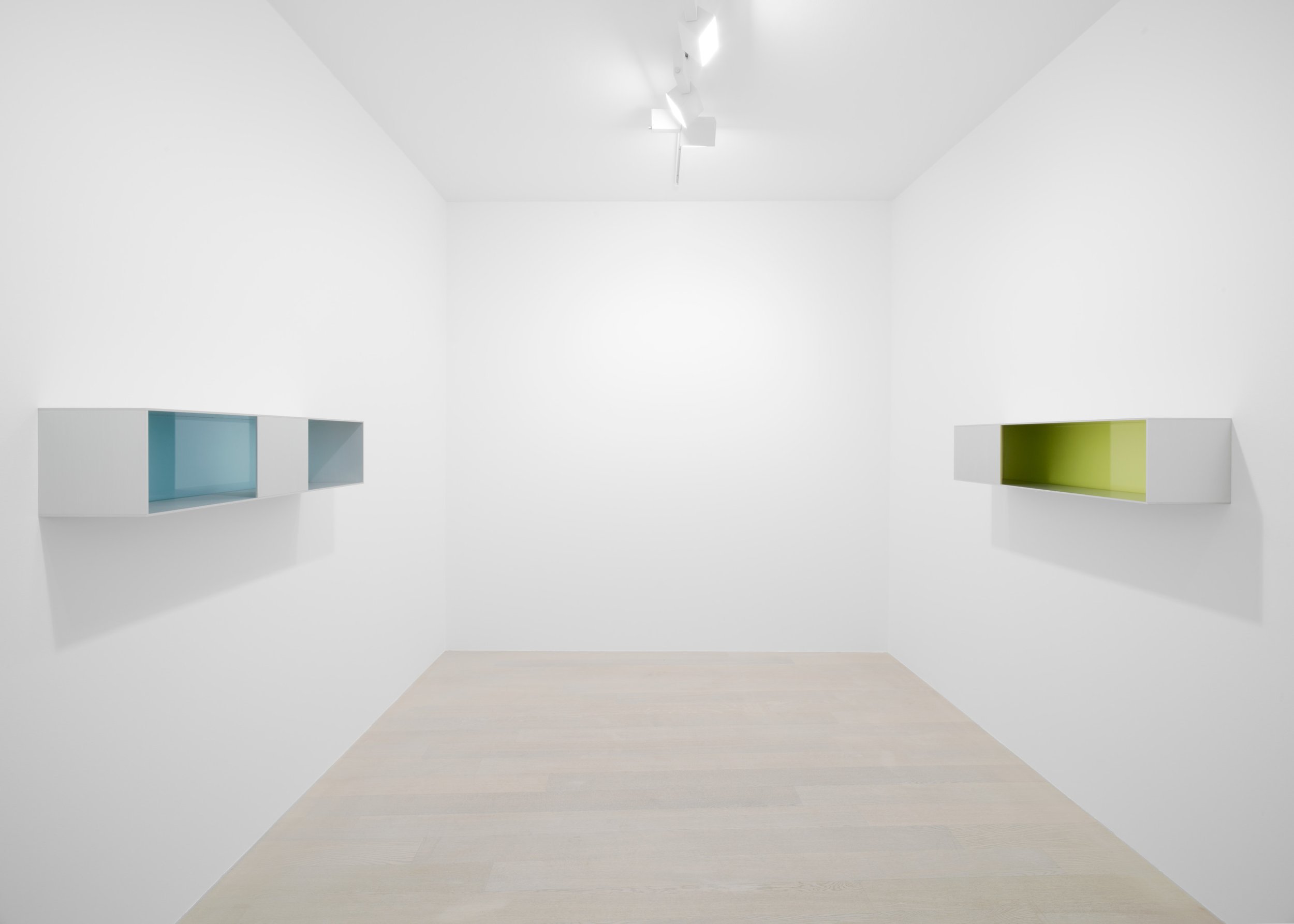Donald Judd :Wall Works
Donald Judd, Basel, Installation View, 2024 © Judd Foundation/Artists Rights Society (ARS), New York Photo: Maris Hutchinson Courtesy Gagosian
Material, space, and color are the main aspects of visual art. Everyone knows that there is material that can be picked up and sold, but no one sees space and color.
—Donald Judd
BASEL,—Gagosian is pleased to announce an exhibition of works by Donald Judd opened at the Basel gallery on June 10. Ten single-unit, wall-mounted works made by the artist in Switzerland between 1987 and 1991 will be on view. Each work measures 25 × 100 × 25 centimeters (approximately 10 × 39 × 10 inches) and is fabricated in Judd’s signature mediums: anodized aluminum and plexiglass sheets in a range of opacities and colors, from amber and chartreuse to black.
DONALD JUDD Untitled, 1991 Clear and turquoise anodized aluminum with blue over red plexiglass 9 7/8 x 39 3/8 x 9 7/8 inches (25 x 100 x 25 cm) © Judd Foundation/Artists Rights Society (ARS), New York Photo: Maris Hutchinson Courtesy Gagosian
Judd’s radical art making and thinking helped shape the look of the late twentieth century and continues to influence artists, architects, and designers worldwide. He has exercised a transformative impact on the ways in which both art objects and practical designs are produced, exhibited, encountered, and used. Through his globally recognized visual work and his incisive critical and theoretical writing, Judd introduced an art that exists on its own determinedly physical terms, removed from notions of metaphor and illusion and about the here and now with no recourse to past narratives. Individually, each of his works delineates created interior space and the exterior space it occupies; there are no identical works within the group.




Donald Judd, Basel, Installation View, 2024 © Judd Foundation/Artists Rights Society (ARS), New York Photo: Maris Hutchinson Courtesy Gagosian
These precisely constructed works are defined by Judd’s interest in materials and color. Non- referential and self-contained, they emphasize the intrinsic qualities of their components and the relationships between part and whole. The uniform proportionality of their exteriors exists in relation to their interior divisions, as the matte sheen of aluminum contrasts with the glossy or translucent plexiglass sheets positioned on the works’ vertical surfaces closest to the wall. The compositions are bisected by aluminum sheets, with some works partitioned by aluminum planes on their front- facing surfaces. Orchestrating subtle and dramatic interplays of light, shadow, and color, the pieces investigate space, color, and existence—for Judd, the main concerns of art.
DONALD JUDD Untitled, 1991 Clear anodized aluminum with amber over yellow plexiglass 9 7/8 x 39 3/8 x 9 7/8 inches (25 x 100 x 25 cm) © Judd Foundation/Artists Rights Society (ARS), New York Photo: Maris Hutchinson Courtesy Gagosian
Judd spent significant time in Switzerland, and key exhibitions of his work were mounted there from 1969, including at Kunstmuseum Basel in 1976 and 2004. In 1987, he established Eichholteren, a home and studio on a lakeside site near Küssnacht-am-Rigi, remodeling its architecture through 1993.
DONALD JUDD Untitled, 1991, detail Clear and turquoise anodized aluminum 9 7/8 x 39 3/8 x 9 7/8 inches (25 x 100 x 25 cm) © Judd Foundation/Artists Rights Society (ARS), New York Photo: Maris Hutchinson Courtesy Gagosian
The exhibition in Basel coincides with the gallery’s participation in Art Basel (June 12–16), which includes the presentation of a historic large-scale work by Judd from 1970 in the Unlimited sector for monumental artworks. The untitled installation consists of five-foot-high galvanized iron panels that stand end to end on the floor to form a continuous band exactly eight inches from the surrounding walls. First shown by Leo Castelli in New York, the work’s configuration is both variable and directly related to its site, transforming the architectural space where it is installed.





Donald Judd, Basel, Installation View, 2024 © Judd Foundation/Artists Rights Society (ARS), New York Photo: Maris Hutchinson Courtesy Gagosian
Donald Judd was born in 1928 in Excelsior Springs, Missouri, and died in 1994 in New York. Collections include Kunstmuseum Basel; Kunstmuseum Bern; Museum Ludwig, Cologne, Germany; Centre Pompidou, Paris; Tate, London; Museum of Modern Art, New York; Solomon R. Guggenheim Museum, New York; National Gallery of Art, Washington, DC; San Francisco Museum of Modern Art; and Museum of Contemporary Art Tokyo. Exhibitions include the Whitney Museum of American Art, New York (1968 and 1988); Van Abbemuseum, Eindhoven, Netherlands (1970, traveled to Museum Folkwang, Essen, Germany; Kunstverein Hannover, Germany; and Whitechapel Art Gallery, London); National Gallery of Canada, Ottawa (1975); and Tate Modern, London (2004, traveled to Kunstsammlung Nordrhein Westfalen, Düsseldorf, Germany; and Kunstmuseum Basel). The Museum of Modern Art, New York, presented a major retrospective of Judd’s work in 2020–21. Judd established Judd Foundation in 1977 to preserve his art, spaces, libraries, and archives in New York and in Marfa, Texas. He founded the Chinati Foundation/La Fundación Chinati in 1986 for the permanent installation of his and his contemporaries’ large-scale works.
For more information about this exhibition and others presented by Gagosian please visit the gallery’s site here. The gallery can also be found on Pinterest, X, YouTube, Facebook, Instagram, and Artsy.



